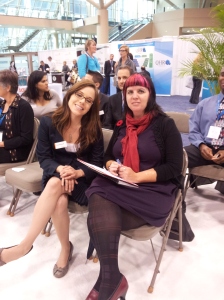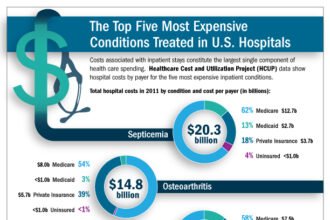On day 2 of HealthAchieve, Ashley Weinhandl, Marketing Coordinator with the Ontario Hospital Association and I had had the pleasure to interview Janice Nicholson.
On day 2 of HealthAchieve, Ashley Weinhandl, Marketing Coordinator with the Ontario Hospital Association and I had had the pleasure to interview Janice Nicholson. Janice is the Senior Manager of Strategic Communications at The Hospital for Sick Children (SickKids) for the past 4 years.
Our presentation opened with the same preamble about social networking and community building that Ashley and I shared on Day 1. So, I’ll fast forward directly to the interview with Janice and the nuggets she share with us.
Ashley: Who did you want to connect with through social media and why?
Janice:
First and foremost, we know more and more Canadians are turning to the internet to obtain health information and we feel it is our responsibility to be out there to ensure that accurate, reliable information is available. And although this isn’t a unique answer, like others, we wanted to reach out to patients, families and the public in general. We felt it was where things were going with our demographic, since social media is where younger generations are gathering. It was a new and challenging way to tell our story, promote our causes and build community.
Colleen: How did you get started? What social media tools do you use?
Janice:
In determining the social media tools to utilize, we felt Twitter (@SickKidsNews) and YouTube were a good place to start because they we perceived them to pose the least risk. For Twitter, we started by adopting a listening mode at the beginning and using Twitter to push out messages and drive traffic to our website. It was another way to amplify what was already out there and engage in a new communications channel. For YouTube, early on it was part of our social media news releases and we have now established it further. The challenge with YouTube is consent and privacy issues, specifically with our young patients. No videos or images may be posted without the express consent of every individual. Producing videos of a high enough quality can also be extremely time consuming and cost prohibitive so this is an avenue we are still exploring. However, we continue to work on this and our ability to share stories through this channel.
Our Foundation (@sickkids) was already active on social media and had established Twitter, YouTube, Facebook channels. As the Hospital we have a different motivation over and above fundraising. We took on the role of providing information to our stakeholders. We are motivated to reach out to our audiences for the purposes of education, knowledge translation and community building and to support our patients and families.
Ashley: Tell us about your experience. What unique learnings have you encountered?
Janice:
I’ve learned that it’s important to manage expectations about social media. It is not the solution to all of our communications challenges; it is simply another tool in our tool kit. I also have come to believe that to have a real effect in the social network, we need to have a coordinated approach. We have a strong brand and to maximize our voice and reach our audience on channels like Twitter, we need to maintain one brand. By having too many voices out there we end up splintering off into smaller channels. If we maintain master accounts, we can share the messages of all of our SickKids family through one voice and reach a wider audience. The key is to target those messages using keywords and hashtags.
There is a lot of interest in embracing social media at SickKids, but we must manage expectations of who is using social media at SickKids and how they will represent our brand. We are taking a phased approach and now that we have taken the time to listen and are beginning to establish a voice, we are on to the next phase. We plan to continue to build as we start to engage our staff and stakeholders and help engage them in the conversation.
Colleen: What other ways are you building community online at SickKids?
Janice:
As a pediatric institution we have to be particularly careful about engaging our patients in safe environments and not expose them to any risks. At the same time we know how important it is for our young patients to be able to engage with friends and family and with other kids that are going through the same things that they are. We are thrilled to be part of the Upopolis network. This specially designed social network was inspired by the hospital experiences of two adolescent friends, one of whom went on to create this network. Upopolis is a social networking site for our in-patients and patients that we have a long-term relationship with and allows them to stay connected with other patients, friends and family. It is password protected and managed through our child life program. Patients access the site from computers that have been donated for them to use in the hospital. It is also available at other pediatric institutions in Canada.
Upopolis is like a mini-Facebook, but moderated. It allows children to connect and share life experiences and challenges with kids going through same thing. The scrapbooking program is a widely used program on the site, allowing the kids to use art, photography etc to express themselves creatively. It is important to note that many of these children face isolation because their illnesses and complex treatment regimes do not allow them to have the same social interactions as other kids. Upopolis allows them to reach out to other kids who face similar barriers and establish important relationships.
Ashley: What one piece of advice would you give other institutions for community building?
Janice:
Get involved with social media as fast as you can because if you’re not there they will still be talking about you. Being there allows you to know what is being said so you can respond accordingly.
Since it’s free, it is a great tool for not-for-profit and publicly funded institutions. The important thing to remember is that you are entering a channel that moves at a crazy speed and you need to be extremely responsive. So while it is free to use, it requires resources and an investment of time and strategy. There are resources required and you have to take it seriously and have a plan.
Colleen:
Thank you for joining us today Janice and affording a glimpse behind the social media strategy at SickKids.
What about your institution? Do encourage team members to use their own social media accounts (Twitter, blogs for example) or do they communicate through a central channel? Do you separate your foundation and hospital social media channels?
Filed under: Community Management, hcsmca, Health Care, Social Media Tagged: community management, healthcare communications, hospital, SickKids, social media
![]()








